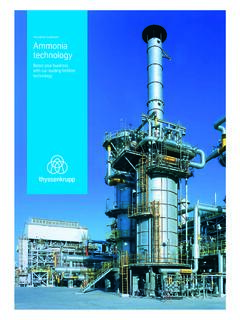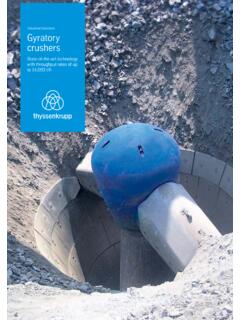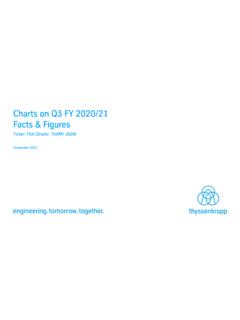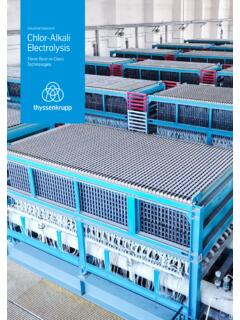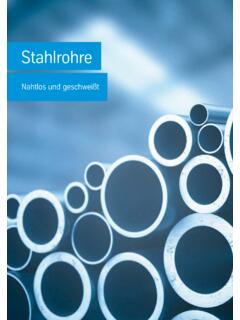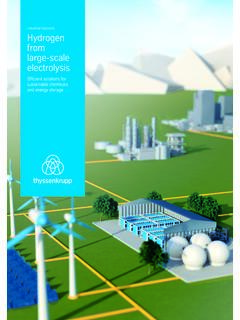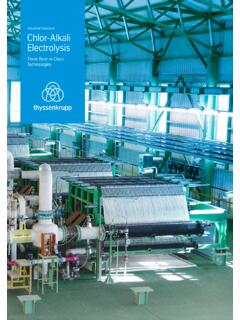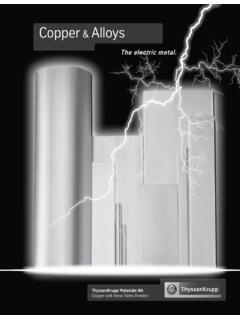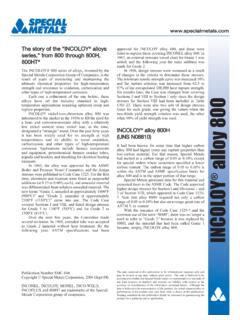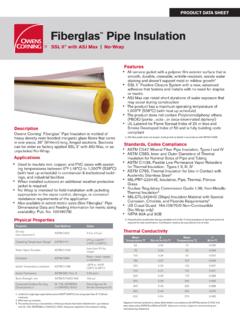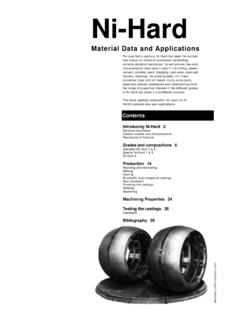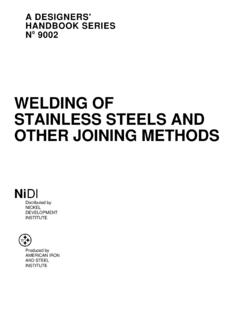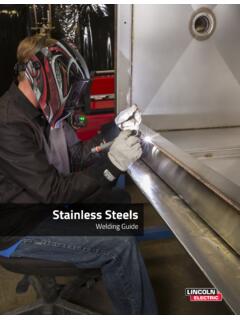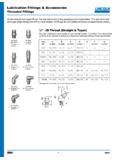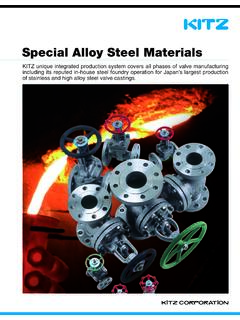Transcription of Stainless Steel 1.4404 - ThyssenKrupp
1 ThyssenKrupp Materials (UK) Ltd Stainless Steel Material Data Sheet This data sheet applies to hot and cold-rolled sheets/plates and strip, semi-finished products, rods, rolled wire and profiles as well as seamless and welded tubes for pressure purposes. Application Construction encasement, doors, windows and armatures, offshore modules, cisterns and pipes for chemical tankers, production, warehousing and overland transportation of chemicals, food and beverages, pharmacy, synthetic fibre, paper and textile plants and pressure vessels. Due to the low C-content, the resistance to intergranular corrosion is also guaranteed in the welded condition. Chemical Composition (heat analysis in %)a). C Si Mn P S N Cr Mo Ni 1). - - - a).
2 Maximum value unless otherwise stated. 1). For machinability a controlled sulphur content of - is recommended and permitted. Mechanical Properties (at room temperature in solution annealed condition). Impact energy (ISO-V). Tensile Yield Strength Elongation Room Temperature 10mm Strength Thick Thickness Product Form mm max. 1%. A1) % min A1) % min J min. J min. n/mm2 N/mm2 Rm N/mm2. (longitudinal) (transverse) (longitudinal) (transverse). min. min C 8 2403) 2703) 530 - 6803) - 40 - - H 2203) 2603) 530 - 6803) - 40 100 60. P 75 2203) 2603) 520 - 6703) - 45 100 60. L 160 200 4). 235 4). 500 - 7004) 40 - 100 - L 250 2). 200 5). 235 5). 500 - 700 3). - 30 - 60. Tw/s 60 1906) 2406) 490 - 6904) 40 30 100 607). 1). Gauge length and thickness according to DIN EN.
3 2). > 160mm 3). Transverse test piece, with product widths < 300mm longitudinal test piece 4). Longitudinal test piece 5). Transverse test piece 6). Longitudinal test piece, external diameter > 508mm transverse test piece 7). Min. 60 j at - 196 C. Page 1 Material Data Sheet 11/2017. ThyssenKrupp Materials (UK) Ltd Stainless Steel Material Data Sheet Reference data on some physical properties Modulus of Elasticity kN/mm2 at Specific Electrical Density at 20 C Thermal Conductivity Specific Thermal Ca- Resistivity at 20 C . kg/dm3 20 C 200 C 400 C 500 C at 20 C W/m K pacity at 20 C J/kg K. mm2/m 200 186 172 165 15 500 Linear coefficient of thermal expansion 10-6 K-1 between 20 C and 100 C 200 C 300 C 400 C 500 C. Guidelines on the temperature for hot forming and heat treatment1).
4 Hot Forming Heat Treatment AT (Solution Annealed), Microstructure Temperature C Type of Cooling Temperature C 2) 3) 4) Type of Cooling Microstructure Austenite with a low content 1150 to 850 Air 1030 to 1110 Water, air of ferrite 1). For simulative heat treatment test pieces the temperatures for solution annealing have to be agreed. 2). Solution annealing is in applicable, if the conditions for the hot forming and the concluding cooling are in such a way that the requirements for the mechanical properties of the product can be maintained. 3). If heat treatment is carried out in a continuous annealing furnace, usually the upper area of the mentioned temperature range is preferred or even exceeded. 4). For heat treatment within subsequent processing, the lower area of the stated temperature range for solution annealing has to be aspired, as otheriwse the mechanical properties could be affected.
5 If the lower limit for the solution annealing temperature was not undercut during hot forming, while repeating annealing a temperature of 1000 C as the lower limit is sufficient. Processing / Welding Standard welding process for these Steel grades are: TIG-Welding MAG-Welding Solid Wire Arc Welding (E). Submerged Arc Welding (SAW). Laser Bean Welding Filler Metal Process Similar Higher Alloyed TIG Thermanit GE-316 L Thermanit A MAG Solid Wire Thermanit GE-316 L Si Thermanit A Si Thermanit GE Special Thermanit A Special Arc Welding (E). Thermanit GEW 316 L-17 Thermanit AW Wire Powder Wire Powder SAW Marathon 431 Thermanit A Marathon 431 - 213. Thermanit GE-316L. Marathon 213 Thermanit 18/17 E Marathon 104. Laser Beam Welding See Page 3.
6 Page 2 Material Data Sheet 11/2017. ThyssenKrupp Materials (UK) Ltd Stainless Steel Material Data Sheet When choosing the filler metal, the corrosion stress has to be regarded, as well. The use of a higher alloyed filler metal can be necessary due to the cast structure of the weld metal. A preheating is not necessary for this Steel . A heat treatment after welding is normally is normally not usual. austenitic steels only have 30% of the thermal conductivity of non-alloyed steels. Their fusion point is lower than that of non-alloyed Steel therefore austenitic steels have to be welded with lower heat input than non-alloyed steels. To avoid overheating or burn-though of thinner sheets, higher welding speed has to be applied.
7 Copper back-up plates for faster heat rejection conductivity a greater distortion has to be expected. When welding all procedures, which work against this distrotion (eg. back-step sequence welding, welding alternately on opposite sides with double-V butt weld, assignment of two welders when the components are accordingly large) have to be respected notably. For produc thicknesses over 12mm the double-V butt weld has to be preferred instead of a single-V butt weld. The included angle should be 60 - 70 , when using MIG-welding about 50 are enough. An accumulation of weld seams should be avoided. Tack welds have to be afficed with relatively shorter distances from each other (significantly shorter than those of on-alloyed steels), in order to prevent strong deformation, shrinking, or flaking tak welds.
8 The tacks shoudl be subsequently grinded or at least be free from crater cracks. in connection with austenitic weld metal and too high heat input the addiction to form heat cracks exists. the addiction to heat cracks can be confined, if the weld metal features a low content of ferrite (delta ferrite). Contents of ferrite up to 10% have a favourable effect and do not affect the corrosion resistance generally. The thinnest layer as possible have to be welded (stringer bead technique) because a higher cooling speed decreases the addition to hot cracks. A preferably fast cooling has to be aspired while welding as well, to avoid the vulnerability to intergranular corrosion and embrittlement. is very suitable for laser beam welding (weldability A in accordance with DVS bulletin 3203, part 3) Witha welding groove width smaller respectively product thickness the use of filler metals is not necessary.
9 With larger welding grooves a similar filler metal can be used. With avoiding oxidation within the seam surface during laser beam welding by applicble backhand welding, eg. helium as inert gas, the welding seam is as corrosion resistant as the base metal. A hot crack hazard for the welding seam does not exist, when choosing an applicable process. is also suitable for laser beam fusion cutting with nitrogen or flame cutting with oxygen. The cut edges only have small heat affected zones and are generally free of micro cracks and thus are well formable. While choosing an applicable process the fusion cut edges can be converted directly. Especially, they can be welded without any further preparation. While processing only Stainless tools like Steel brushes, pnematic picks and so on are allowed, in order to not endanger the passivation.
10 It should be neglected to mark within the welding seam zone with oleigerous bolts or temperature indicating crayons. The high corrosion resistance of this Stainless Steel is based on the formation of a homogeneous, compact passive layer on the surface. Annealing colours, scales, slag residues, tramp iron, spatter and such like have to be removed in order to not destroy the passive later. For cleaning the surface the processes brushing, grinding, pickling or blasting (iron-free silica sand or glas spheres) can be applied. For brushing only Stainless Steel brushes can be used. Pickling of the previously brushed seam area is carried out by dipping and spraying, however, often pickling pastes or solutions are used. After pickling, carefully flushin with water must be done.
